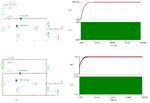truffaldino
Junior Member level 3

Hello
I would like to measure Voltage swing Vpp (or even Vmin and Vmax) in up to 50Mhz range with help od DC multimeter and a reasonably simple and cheap diy circuit.
There is a lot of schematics on the net based on diode rectifiers, but these will not work at high frequency.
I will be grateful for useful links
Truffaldino
I would like to measure Voltage swing Vpp (or even Vmin and Vmax) in up to 50Mhz range with help od DC multimeter and a reasonably simple and cheap diy circuit.
There is a lot of schematics on the net based on diode rectifiers, but these will not work at high frequency.
I will be grateful for useful links
Truffaldino









